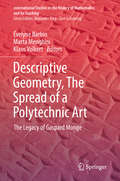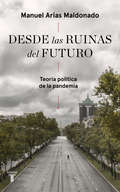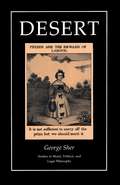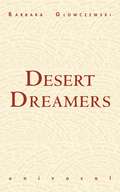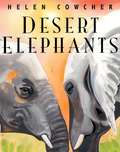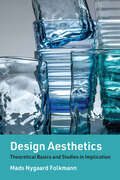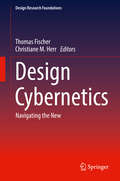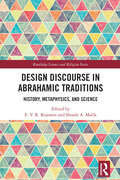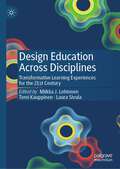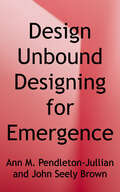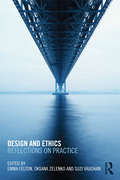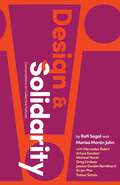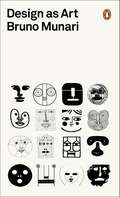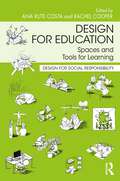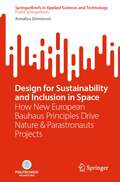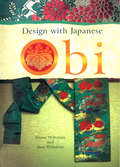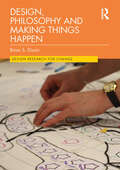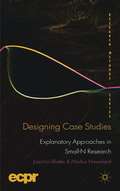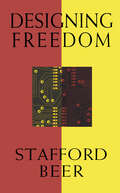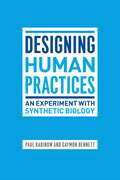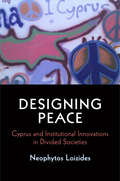- Table View
- List View
Descriptive Geometry, The Spread of a Polytechnic Art: The Legacy of Gaspard Monge (International Studies in the History of Mathematics and its Teaching)
by Klaus Volkert Évelyne Barbin Marta MenghiniThis book seeks to explore the history of descriptive geometry in relation to its circulation in the 19th century, which had been favoured by the transfers of the model of the École Polytechnique to other countries. The book also covers the diffusion of its teaching from higher instruction to technical and secondary teaching. In relation to that, there is analysis of the role of the institution – similar but definitely not identical in the different countries – in the field under consideration. The book contains chapters focused on different countries, areas, and institutions, written by specialists of the history of the field. Insights on descriptive geometry are provided in the context of the mathematical aspect, the aspect of teaching in particular to non-mathematicians, and the institutions themselves.
Descriptive Psychology (International Library of Philosophy)
by Franz BrentanoFranz Brentano (1838-1917) is a key figure in the development of Twentieth Century thought. It was his work that set Husserl on to the road of phenomenology and intentionality, that inspired Meinong's theory of the object which influenced Bertrand Russell, and the entire Polish school of philosophy.^Descriptive Psychology presents a series of lectures given by Brentano in 1887; they were the culmination of his work, and the clearest statement of his mature thought. It was this later period which proved to be so important in the work of his student, Husserl.This is the first English translation of his work. Benito Muller has added a concise introduction which places Brentano within the history of philosophy and psychology, and locates his influence in contemporary thought.
Desde las ruinas del futuro
by Manuel Arias MaldonadoSi queremos evitar futuros sobresaltos, es necesario explicar la crisis y elucidar sus significados. La pandemia de la COVID-19 ha sacudido a la humanidad con una fuerza inopinada: un virus de origen animal ha obligado a los ciudadanos de gran parte del globo a quedarse en casa, y el mundo acelerado de la globalización se ha detenido ante la mirada perpleja de los contemporáneos. Millones de personas han enfermado y cientos de miles han muerto, mientras el uso masivo de las mascarillas nos recordaba a diario que la habitabilidad del planeta no puede darse por supuesta. Así que, un siglo después de la Gripe Española, otro virus infeccioso ha actuado como agente histórico de primer orden. Y esta catástrofe inesperada, mas no imprevista, aguarda ahora a sus intérpretes. Manuel Arias Maldonado se aproxima a la pandemia como al fenómeno polisémico que es: efecto colateral de las relaciones socionaturales y riesgo global que a duraspenas encaja en las categorías dominantes; la acción del virus fuerza a las democracias a operar en condiciones excepcionales dominadas por la incertidumbre. Pero el virus también activa nuevos imaginarios colectivos y reabre el debate sobre un futuro que se presenta menos como promesa que como amenaza. Rehuyendo cualquier tentación profética, el autor defiende la capacidad del viejo pensamiento ilustrado para procesar con éxito este acontecimiento sublime, cuya causa no debe buscarse en el fracaso de la modernidad sino en su carácter asimétrico e inacabado. La crítica ha dicho sobre el autor:«Leer a Arias Maldonado siempre nos ayuda a entender cómo está cambiando el mundo.»Daniel Gascón, Letras Libres «Arias Maldonado no es un politólogo sino un filósofo político. La diferencia entre ambos oficios es la misma que separa al interiorista del arquitecto. Arias es un académico cuya kantiana ambición es toda la que quepa en la consideración científica de la política. Su trabajo trasciende el corral patrio para dialogar con homólogos extranjeros sobre desafíos estructurales de la democracia occidental.»Jorge Bustos, El Cultural
Desert (Studies in Moral, Political, and Legal Philosophy #3)
by George SherThe description for this book, Desert, will be forthcoming.
Desert Collapses: Why No One Deserves Anything (Routledge Studies in Ethics and Moral Theory)
by Stephen KershnarPeople consider desert part of our moral world. It structures how we think about important areas such as love, punishment, and work. This book argues that no one deserves anything. If this is correct, then claims that people deserve general and specific things are false. At the heart of desert is the notion of moral credit or discredit. People deserve good things (credit) when they are good people or do desirable things. These desirable things might be right, good, or virtuous acts. People deserve bad things (discredit) when they are bad people or do undesirable things. On some theories, people deserve credit in general terms. For instance, they deserve a good life. On other theories, people deserve credit in specific terms. For instance, they deserve specific incomes, jobs, punishments, relationships, or reputations. The author’s argument against desert rests on three claims: There is no adequate theory of what desert is. Even if there were an adequate theory of what desert is, nothing grounds (justifies) desert. Even if there were an adequate theory of what desert is and something were to ground it, there is no plausible account of what people deserve. Desert Collapses will be of interest to researchers and advanced students working in ethics and political philosophy.
Desert Dreamers (Univocal)
by Barbara GlowczewskiIn the heart of Australia, on the cracked red earth, among wild vegetation, weathered bush, and dried-up creeks, hundreds of invisible pathways exist that become entangled on the earth's surface, underground, and in the sky, clouds, and wind. The Aboriginal people call them Jukurrpa: &“the Dreamings.&” This web is the Warlpiri land. Practicing the Dreaming, by ritual art, is for the Warlpiri a way to reactivate their ancestral traditions to connect with the cosmos and respond to current social and political issues.In 1979, anthropologist Barbara Glowczewski embarked on a journey to study the Warlpiri in the Australian outback. Struggling at once to maintain their traditions and cultural heritage as well as adapting to the continuing secularization and techno-progress of their European Australian counterparts, she takes us into the landscape, artistic rituals, and turmoil of the Warlpiri over three decades. Becoming accepted among Aboriginal families as a translator, and at the same time a negotiator of two vastly different visions of the earth, contemporary Western culture and the ancient indigenous dreaming culture, Glowczewski created a singular document of ethnological fieldwork and of self-transformation and discovery.
Desert Elephants
by Helen CowcherEach year the desert elephants of Mali, West Africa, travel a 300-mile path to search for water. <P><P>They peacefully pass through the lands of the Tuareg, Dogon, and Fulani people while following the longest migration route of any elephant in the world. <P><P>This insightful story with bold, dramatic illustrations shows how people work together to preserve the delicate balance of life in the desert and protect these magnificent elephants.
Design Aesthetics: Theoretical Basics and Studies in Implication (Design Thinking, Design Theory Ser.)
by Mads Nygaard FolkmannAn original exploration of the role of aesthetics in contemporary design, uniquely combining philosophical aesthetics and cultural analysis of design.As a product of human ingenuity, design functions as an artificial interface through which we meet the world. While the ubiquity of design seems to render it imperceptible, when we truly reflect on design, we see that it is inextricably entwined with our experience of the world. In Design Aesthetics, Mads Nygaard Folkmann provides an engaging introduction to the field of design aesthetics and its role as a concept. Engaging with sensual, conceptual, and contextual considerations of design aesthetics, this book investigates design experience in tandem with design practice, objects, and perception.Part one of Design Aesthetics lays the theoretical foundation by differentiating between sensual, conceptual, and contextual dimensions of design aesthetics and clarifying what &“aesthetic experience&” means in relation to design. The second part of the book consists of studies in implications of design aesthetics for design practice, design objects with embedded technology, and the construction of perception of aesthetic qualities in objects. In its focus on design aesthetics, the book is intended for everyone working with design—design students, designer researchers, and designers—as well as students and researchers in aesthetics in general.
Design Cybernetics: Navigating the New (Design Research Foundations)
by Thomas Fischer Christiane M. HerrDesign Cybernetics: Navigating the New Design cybernetics offers a way of looking at ourselves – curious, creative, and ethical humans – as self-organising systems that negotiate their own goals in open-ended explorations of the previously unknown. It is a theory of and for epistemic practices (learning, designing, researching) that is deeply committed to the autonomy of others and hence offers no prescriptive methodology. Design cybernetics describes design practice as inextricable from conversation – a way of enquiring, developing shared understanding and reaching the new that harnesses reliable control as well as error and serendipity. Recognising circular causality, observer-dependency and non-determinability, design cybernetics extends beyond tenets of scientific research into the creative, ethical and aesthetic domain. From this perspective, design is not an ill-conceived subset of scientific research. Instead, scientific research emerges as a particularly restricted subset of the broader human activity of design. This volume offers a cross-section of design cybernetic theory and practice with contributions ranging across architecture, interior lighting studies, product design, embedded systems, design pedagogy, design theory, social transformation design, research epistemology, art and poetics, as well as theatre and acting. Addressing designers, design educators and researchers interested in a rigorous, practice-based epistemology, it establishes design cybernetics as a foundational perspective of design research. “This is a conceptually elegant, well structured, and comprehensive presentation of design cybernetics. It fills a gap in the literature of the field.” Ken Friedman, Chair Professor, Tongji University “This book offers a valuable and timely introduction to second-order cybernetics as society grapples with complex issues like climate change and rising inequality.” Joichi Ito, Director of the MIT Media Lab
Design Discourse in Abrahamic Traditions: History, Metaphysics, and Science (Routledge Science and Religion Series)
by E. V. R. Kojonen Shoaib A. MalikDesign Discourse in Abrahamic Traditions reconnects discussion of design arguments to its Jewish, Christian, and Muslim history. The ancient idea that there is evidence of purpose in nature remains one of the most debated topics in science and religion, but also one with great potential for inter-religious and interdisciplinary dialogue. This volume revitalizes current discussion by retrieving perspectives from the Abrahamic history of design arguments and engaging them with contemporary ideas. Beginning with the encounter ancient philosophy and creation beliefs, the book proceeds to delve deep into issues ranging from the nature of theological and teleological language to the implications of evolution and evil. This rich exploration showcases how, far from being irrelevant in a post-Humean, post-Darwinian world, design arguments continue to merit both popular-level and academic attention. The volume will be of particular interest to scholars working at the intersection of science and religion, philosophers of religion, and theologians.
Design Education Across Disciplines: Transformative Learning Experiences for the 21st Century
by Miikka J. Lehtonen Tomi Kauppinen Laura SivulaThis book explores how design thinking can transform higher education, with solutions ranging from single course sessions to whole programs and universities. The authors demonstrate how designing across disciplines is done, with disruptive technologies, ambiguity and challenges as catalysts. Iteratively tested pedagogies, design-driven solutions and creative uses of both tactile and digital worlds are among the approaches discussed. Educators and leaders of higher education institutes as well as designers and managers of companies will benefit from engaging the design ideas in their own work.
Design Education in India: Values of Socially Responsible Design (Routledge Research in Social Design)
by Sanjeev BothraThis book traces developments in design education in India and shows the continuing impact of the Bauhaus School of design education, which formed the basis of the National Institute of Design. It presents the findings of the author's research and experiential learning as a design educator over a 25-year period. This book argues that as the effects of climate change and the exploitation of natural and human resources become more pervasive, it has become increasingly important to ensure that the values of social responsibility are instilled into the design students who will become future practitioners. This book offers an alternative model of understanding regarding the ecosystem of design and sustainable design education. Going beyond description and analysis, it includes three case studies of adoptable design curricula created by the author, with student responses to the programmes to provide first-hand insights into their impact. Research findings are based on detailed interviews with contemporary faculty members, all experts in the various design disciplines, along with an in-depth survey of existing design programmes in India. Design Education in India encourages a paradigm shift in thinking about the environment, spaces and places. It offers a unique perspective on the status of design education in an important and fast-growing economy and will be a useful read for design educators and researchers in varied disciplines.
Design Unbound: Designing for Emergence in a White Water World, Volume 1 (Infrastructures Series)
by John Seely Brown Ann Pendleton-JullianThis book presents a new tool set for having agency in the twenty-first century, in what the authors characterize as a white water world-rapidly changing, hyperconnected, and radically contingent. These are the tools of a new kind of practice that is the offspring of complexity science, which gives us a new lens through which to view the world as entangled and emerging, and architecture, which is about designing contexts. <p><p>In such a practice, design, unbound from its material thingness, is set free to design contexts as complex systems. In a world where causality is systemic, entangled, in flux, and often elusive, we cannot design for absolute outcomes. Instead, we need to design for emergence. This book not only makes this case through theory but also presents a set of tools to do so. <p><p>With case studies that range from a new kind of university to organizational, and even societal, transformation, the book draws from a vast array of domains- architecture, science and technology, philosophy, cinema, music, literature and poetry, even the military. It is presented in five books, bound as two volumes. Different books within the larger system of books will resonate with different reading audiences, from architects to people reconceiving higher education to the public policy or defense and intelligence communities. The authors provide different entry points allowing readers to navigate their own pathways through the system of books.
Design and Ethics: Reflections on Practice
by Emma Felton Oksana Zelenko Suzi VaughanThe value of design for contributing to environmental solutions and a sustainable future is increasingly recognised. It spans many spheres of everyday life, and the ethical dimension of design practice that considers environmental, social and economic sustainability is compelling. Approaches to design recognise design as a practice that can transform human experience and understanding, expanding its role beyond stylistic enhancement. The traditional roles of design, designer and designed object are therefore redefined through new understanding of the relationship between the material and immaterial aspects of design where the design product and the design process are embodiments of ideas, values and beliefs. This multi-disciplinary approach considers how to create design which is at once aesthetically pleasing and also ethically considered, with contributions from fields as diverse as architecture, fashion, urban design and philosophy. The authors also address how to teach design based subjects while instilling a desire in the student to develop ethical work practices, both inside and outside the studio.
Design and Solidarity: Conversations on Collective Futures
by Rafi Segal Marisa Morán JahnIn times of crisis, mutual aid becomes paramount. Even before the COVID-19 pandemic, new forms of sharing had gained momentum to redress precarity and stark economic inequality. Today, a diverse array of mutualistic organizations seek to fundamentally restructure housing, care, labor, food, and more. Yet design, art, and architecture play a key role in shaping these initiatives, fulfilling their promise of solidarity, and ensuring that these values endure.In this book, artist Marisa Morán Jahn and architect Rafi Segal converse about the transformative potential of mutualism and design with leading thinkers and practitioners: Mercedes Bidart, Arturo Escobar, Michael Hardt, Greg Lindsay, Jessica Gordon Nembhard, Ai-jen Poo, and Trebor Scholz. Together, they consider how design inspires, invigorates, and sustains contemporary forms of mutualism—including platform cooperatives, digital-first communities, emerging currencies, mutual aid, care networks, social-change movements, and more. From these dialogues emerge powerful visions of futures guided by communal self-determination and collective well-being.
Design as Art
by Bruno Munari<p>One of the last surviving members of the futurist generation, Bruno Munari's Design as Art is an illustrated journey into the artistic possibilities of modern design translated by Patrick Creagh published as part of the 'Penguin on Design' series in Penguin Modern Classics. <p>'The designer of today re-establishes the long-lost contact between art and the public, between living people and art as a living thing' <p>Bruno Munari was among the most inspirational designers of all time, described by Picasso as 'the new Leonardo'. Munari insisted that design be beautiful, functional and accessible, and this enlightening and highly entertaining book sets out his ideas about visual, graphic and industrial design and the role it plays in the objects we use everyday. Lamps, road signs, typography, posters, children's books, advertising, cars and chairs - these are just some of the subjects to which he turns his illuminating gaze. <p>How do we see the world around us? The Penguin on Design series includes the works of creative thinkers whose writings on art, design and the media have changed our vision forever. <p>Bruno Munari (1907-1998), born in Milan, was the enfant terrible of Italian art and design for most of the twentieth century, contributing to many fields of both visual (paint, sculpture, film, industrial design, graphics) and non-visual arts (literature, poetry). He was twice awarded the Compasso d'Oro design prize for excellence in his field.</p>
Design for Education: Spaces and Tools for Learning (ISSN)
by Ana Rute CostaThis book charts the impact of design on education, specifically focusing on how design can shape the spaces and tools for learning.This edited collection brings together the work of designers, architects, engineers, professionals, educators, and researchers, and presents a series of case studies and research developed from across Europe, North America, South America, Africa, Australia, and Asia. The book provides the tools to develop innovative approaches to design for education, and illustrates the conversation and action required to foster socially responsible design for education. As the contributions show, we must look at education as an input and output of a complex system, and we need to adopt an interdisciplinary multiple stakeholder approach, bringing together experts from a range of different fields and backgrounds as a cohesive strategy to improve future learning and teaching environments.Providing guidance and a theoretical framework for designing spaces and tools for learning, this book will be a useful resource for design and architecture students, as well as practitioners, educational researchers, educational practitioners, policymakers, and behaviour and built environment researchers.
Design for Sustainability and Inclusion in Space: How New European Bauhaus Principles Drive Nature & Parastronauts Projects (SpringerBriefs in Applied Sciences and Technology)
by Annalisa DominoniThis book offers a cutting-edge perspective of design for space to increase astronauts’ wellbeing and performance creating a more sustainable and inclusive environment, but without to forget beauty. The relevant aspect is that these design principles are now also supported and promoted by the European Community with the New European Bauhaus project. It is legitimate to affirm that Space Design is a precursor and inspiring these principles. Space exploration has shown us how results of space research inspire management policies addressing important earth issues such as the responsible use of resources as well as ethical behavior leading to sustainable and inclusive choices. The International Space Station (ISS) is the most successful virtuous example of circular economy and sustainability by almost totally recycling the waste produced. Recently the European Space Agency (ESA) launched the first call for “parastronauts” opening the fly possibilities to people with physical disabilities and thus affirming the principle of inclusion in space. Thanks to design—a bridge between science, technology, and beauty—space opens up to new creative experiments, placing the human being at the center of the interplanetary exploration programs to ensure extra-terrestrial habitats safer, more comfortable, and efficient, where crew will feel “like at home”.
Design with Japanese Obi
by Diane Wiltshire Ann WiltshireIn Design with Japanese Obi, the authors present the obi as it is being used in interiors today, demonstrating simple yet striking techniques for makingthese exquisite kimono sashes the centerpiece of any room's decor. The focus is on seven key uses for obi that are applicable to nearly any setting imaginable, such as: Artistic table arrangements Dining room accents Framing enhancements Fabric coveringsThese and other dramatic and innovative uses of obi in interior design are presented along with such essentials as color coordination, fabric shaping, and accessories for hanging obi. The vivid photographs in this book present some of the most elegant interiors the authors have found, from Tokyo to Washington, D.C., and show the obi being used in today's homes to create a sumptuous, refined, and modern ambiance.
Design, Philosophy and Making Things Happen (Design Research for Change)
by Brian S. DixonDrawing from the work of Dewey, Wittgenstein and Heidegger, this book aims to relate a series of philosophic insights to the practice of engaging in design research for change. These insights are explored and presented as a set of potential strategies for grounding transformative design research within an intellectual context which both embraces and celebrates experience, process and uncertainty. Chapter by chapter, through theory, practical examples and case studies, an accessible narrative opens up around the coupled themes of existence and experience, language and meaning and knowing and truth. The outcome is a rich and detailed perspective on the ways in which philosophy may afford design research for change a means to both explain, as well as understand, not only what it is and what it does, but also what it could be. The book will be of interest to scholars working in design studies, design theory and design research.
Designed to Kill: The Case Against Weapons Research
by John ForgeThe pilot-less drones, smart bombs and other high-tech weapons on display in recent conflicts are all the outcome of weapons research. However, the kind of scientific and technological endeavour has been around for a long time, producing not only the armaments of Nazi Germany and the atomic bombs dropped on Japan, but the catapults used in ancient Greece and Rome and the assault rifles used by child soldiers in Africa. In this book John Forge examines such weapons research and asks whether it is morally acceptable to undertake such an activity. He argues that it is in fact morally wrong to take part in weapons research as its primary purpose is to produce the means to harm others, and moreover he argues that all attempts to then justify participation in weapons research do not stand up to scrutiny. This book has wide appeal in fields of philosophy and related areas, as well to a more general audience who are puzzled about the rate at which new weapons are accumulated.
Designing Case Studies
by Joachim Blatter Markus HaverlandThe authors explore three ways of conducting causal analysis in case studies. They draw on established practices as well as on recent innovations in case study methodology and integrate these insights into coherent approaches. They highlight the core features of each approach and provide advice on each step of the research process.
Designing Freedom (The CBC Massey Lectures)
by Stafford BeerDistinguished cyberneticist Stafford Beer states the case for a new science of systems theory and cybernetics. His essays examine such issues as The Real Threat to All We Hold Most Dear, The Discarded Tools of Modern Man, A Liberty Machine in Prototype, Science in the Service of Man, The Future That Can Be Demanded Now, The Free Man in a Cybernetic World. Designing Freedom ponders the possibilities of liberty in a cybernetic world.
Designing Human Practices: An Experiment with Synthetic Biology
by Paul Rabinow Gaymon BennettIn 2006 anthropologists Paul Rabinow and Gaymon Bennett set out to rethink the role that human sciences play in biological research, creating the Human Practices division of the Synthetic Biology Engineering Research Center—a facility established to create design standards for the engineering of new enzymes, genetic circuits, cells, and other biological entities—to formulate a new approach to the ethical, security, and philosophical considerations of controversial biological work. They sought not simply to act as watchdogs but to integrate the biosciences with their own discipline in a more fundamentally interdependent way, inventing a new, dynamic, and experimental anthropology that they could bring to bear on the center’s biological research.Designing Human Practices is a detailed account of this anthropological experiment and, ultimately, its rejection. It provides new insights into the possibilities and limitations of collaboration, and diagnoses the micro-politics which effectively constrained the potential for mutual scientific flourishing. Synthesizing multiple disciplines, including biology, genetics, anthropology, and philosophy, alongside a thorough examination of funding entities such as the National Science Foundation, Designing Human Practices pushes the social study of science into new and provocative territory, utilizing a real-world experience as a springboard for timely reflections on how the human and life sciences can and should transform each other.
Designing Peace: Cyprus and Institutional Innovations in Divided Societies (National and Ethnic Conflict in the 21st Century)
by Neophytos LoizidesWhy do some societies choose to adopt federal settlements in the face of acute ethnic conflict, while others do not? Neophytos Loizides examines how acrimoniously divided Cyprus could re-unify by adopting a federal and consociational arrangement inspiring similar attempts in its region.Loizides asserts that institutional innovation is key in designing peace processes. Analyzing power-sharing in Northern Ireland, the return of displaced persons in Bosnia, and the preparatory mandate referendum in South Africa, he shows how divided societies have implemented novel solutions despite conditions that initially seemed prohibitive. Turning to Cyprus, he chronicles the breakthrough that led to the exhumations of the missing after 2003, and observes that a society's choice of narratives and institutions can overcome structural constraints. While Loizides points to the relative absence of successful federal and consociational arrangements among societies evolving from the "post-Ottoman space," he argues that neither elites nor broader societies in the region must be held hostages to the past.To effect lasting and positive change, Loizides encourages stakeholders in divided societies to be prepared to identify, redesign, and implement innovative new institutions. Examining successful peace mediations and identifying the shared experience and commonalities between Cyprus and other divided societies promises not only to inform the tackling of the Cyprus problem but also to provide transferable knowledge with broader implications for the fields of peace studies and conflict resolution.
